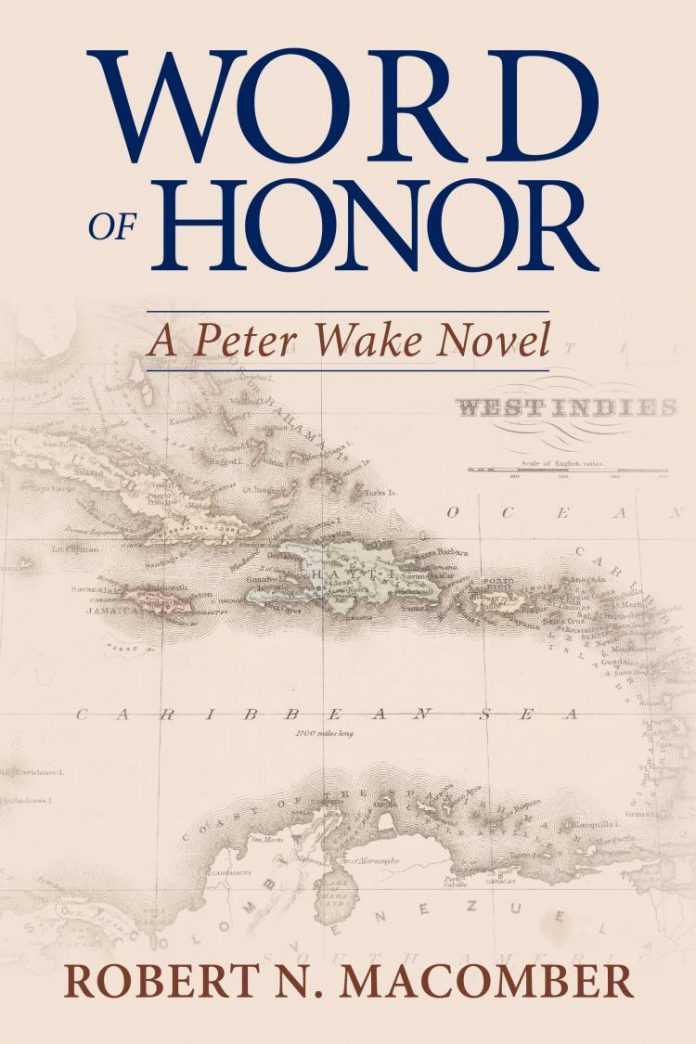
Word of Honor. By Robert N Macomber. Naval Institute Press, Annapolis, 2020.
Reviewed by Tim Coyle
Word of Honor is a historical novel set in 1898 during the Spanish-American war. It is the third of a trilogy on that war but is the latest in the 14 novels on the life of naval adventurer Peter Wake USN.
Wake began his naval career in the US Civil War and retired sometime in 1908 as a rear admiral and adviser to the President. During this period he alternated between sea service and government -sponsored espionage, participation in foreign wars and insurrections through fair means and foul. For uninitiated readers of the Wake sagas, a helpful timeline of Peter Wake’s life from 1839 to early July 1898 is provided.
Peter Wake joined the US Navy during the Civil War through the naval militia and elected to remain in the service at war’s end when many volunteer officers left. As such, Wake was not a graduate of the US Naval Academy and this social hindrance coupled with his unconventional career of covert operations in dubious and dangerous environments, as well as long service in the Office of Naval Intelligence (the first US government foreign intelligence organisation) incurred resentful snobbishness and jealousy among some of the more pedestrian naval officers.
However, Wake is well-connected insofar as he is friends with assistant secretary of the navy Theodore Roosevelt who subsequently became President. Wake is also supported in his adventures by his loyal chief bosun’s mate Rork.
In Word of Honor, Wake is appointed in command of the USS Dixon, a passenger liner converted to an auxiliary cruiser on blockade duties off the Cuban coast. Dixon is manned by a mix of permanent navy personnel and naval militia of indifferent quality. Dixon becomes involved in a classic hide and seek chase of a Spanish raider which must be stopped lest it escape to render havoc against sea lines of communication and possibly bombard eastern US cities. The chase is pursued purely on Wake’s intelligence and seaman’s intuition, unfettered by wireless instructions from higher authority or any other ‘modern’ hindrances to a captain’s initiative, coupled with concerns regarding Dixon’s fuel state and how and where to replenish it.
Through the narrative the reader is alternately diverted to a ‘conversation’ between two admirals, a Captain Smith and Wake, convened in Washington DC in October 1901 after the raider incident. Smith endeavours to drag Wake through accusations of dereliction of duty, disobedience to orders and past alleged indiscretions and to otherwise besmirch Wake’s reputation in order to convince the admirals that they should recommend Wake’s court martial and deny him a pension as his retirement looms.
Smith is in league with Captain Dimm, the lazy and incompetent captain of the USS Bronx, another auxiliary cruiser under Wake’s tactical command in the raider incident. Dimm has congressional political ambitions and both Dimm and Smith are depicted as classic villains seeking Wake’s reputational demise.
The thrilling chase of the Spanish cruiser has a surprise ending without any help from Dimm and his poorly managed Bronx. Wake emerges from the ‘conversation’ with little confidence that the inscrutable admirals will support him against the villainous Smith. However, Wake’s friend, now-President Roosevelt, throws Smith and Dimm ‘under the horse-drawn omnibus’, promotes Wake to rear admiral and engages him as his special adviser.
As the reader progresses through the book as the ‘conversations’ drag out, he or she will feel that Smith and Dimm are so nasty and incompetent that they couldn’t possibly ruin such an upstanding and fearless naval veteran of 40 years’ service to his country while they, snivelling sycophants, skulked in soft billets.
The author, as may be expected, extensively researched the period and conditions of service in the Spanish-American war and furnishes a comprehensive Sources and Notes by Chapter and a Bibliography of research materials.
Word of Honor is a ‘ripping yarn’ and is an enjoyable way of learning about the Spanish-American war. Readers new to Captain Wake may feel moved to relive his other adventures through the preceding 13 novels!



